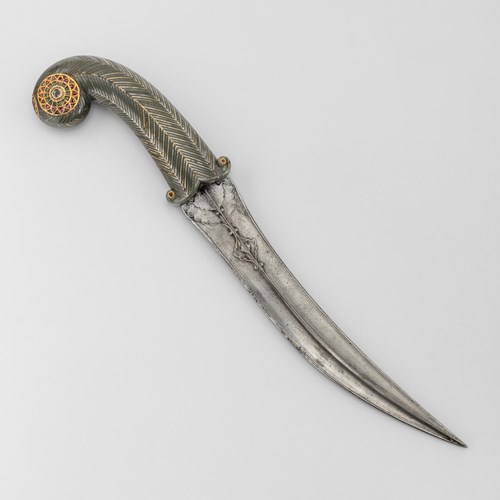Marketplace
Huqqa Base Made for the Indian Market
Huqqa Base Made for the Indian Market
Period 18th century
Origin China, Guangzhou
Medium Enamel
Dimension 20 x 10 cm (7⁷/₈ x 3⁷/₈ inches)
Stock no.: A2985
Huqqas are waterpipes that are used to smoke aromatic tobacco mixtures that come in a wide variety of flavours. They usually work by passing charcoal-heated air through the tobacco mixture and ultimately through a water-filled chamber. A user then inhales the smoke through a tube and a mouthpiece.1 This attractive vessel was the container for water in a huqqa apparatus. Its body swells to a bulbous base in order to provide stability, while its upright neck was appropriate for the fitting of smoking tubes.
Some say that the use of the huqqa spread from India to Persia. After the introduction of tobacco to India by the Jesuits, the huqqa was said to have been invented by a Persian physician to Mughal Emperor Akbar (r.1556 – 1605), who had raised health concerns about smoking tobacco. The pursuit had become popular among Indian noblemen, and the physician envisaged a system that allowed smoke to be passed through water in order to be “purified”. Others maintain that the huqqa originated in the Safavid dynasty of Persia and was transmitted east to India. Whatever its origin, the waterpipe became popular among noblemen throughout the Middle East and India, where it was a status symbol for the aristocracy.
The vessel is enamelled in a style that was particular to Guangzhou. A deep blue ground is painted with twining baoxiang flowers, with acanthus panels at the neck and a rim of lotus petals round the base. Baoxiang or treasure flowers are a type of fictional, hybrid floral design. Each bloom represents a fusion of plant and leaf motifs that originated from different cultures, including India, Central Asia, Persia, Byzantium, Greece and the Chinese domestic arts. Baoxiang flowers were exotic and auspicious, and were used to decorate court and religious objects. Their choice for this export item denotes its high quality, which is reinforced by the palette of enamels used and the detailed manner of decoration. Flowers and leaves are depicted in a range of colours that shade into one another, to make it seem that the design is three-dimensional. The blue ground is rich and glowing. This style of decoration and the colours employed are also seen on vessels manufactured in Guangzhou (Canton) as tribute goods for the Chinese imperial court during the eighteenth century,2 demonstrating the high quality of the piece.
Huqqas are waterpipes that are used to smoke aromatic tobacco mixtures that come in a wide variety of flavours. They usually work by passing charcoal-heated air through the tobacco mixture and ultimately through a water-filled chamber. A user then inhales the smoke through a tube and a mouthpiece.1 This attractive vessel was the container for water in a huqqa apparatus. Its body swells to a bulbous base in order to provide stability, while its upright neck was appropriate for the fitting of smoking tubes.
Some say that the use of the huqqa spread from India to Persia. After the introduction of tobacco to India by the Jesuits, the huqqa was said to have been invented by a Persian physician to Mughal Emperor Akbar (r.1556 – 1605), who had raised health concerns about smoking tobacco. The pursuit had become popular among Indian noblemen, and the physician envisaged a system that allowed smoke to be passed through water in order to be “purified”. Others maintain that the huqqa originated in the Safavid dynasty of Persia and was transmitted east to India. Whatever its origin, the waterpipe became popular among noblemen throughout the Middle East and India, where it was a status symbol for the aristocracy.
The vessel is enamelled in a style that was particular to Guangzhou. A deep blue ground is painted with twining baoxiang flowers, with acanthus panels at the neck and a rim of lotus petals round the base. Baoxiang or treasure flowers are a type of fictional, hybrid floral design. Each bloom represents a fusion of plant and leaf motifs that originated from different cultures, including India, Central Asia, Persia, Byzantium, Greece and the Chinese domestic arts. Baoxiang flowers were exotic and auspicious, and were used to decorate court and religious objects. Their choice for this export item denotes its high quality, which is reinforced by the palette of enamels used and the detailed manner of decoration. Flowers and leaves are depicted in a range of colours that shade into one another, to make it seem that the design is three-dimensional. The blue ground is rich and glowing. This style of decoration and the colours employed are also seen on vessels manufactured in Guangzhou (Canton) as tribute goods for the Chinese imperial court during the eighteenth century,2 demonstrating the high quality of the piece.
Period: 18th century
Origin: China, Guangzhou
Medium: Enamel
Dimension: 20 x 10 cm (7⁷/₈ x 3⁷/₈ inches)
Literature: Footnotes:
1. Hugh Chisholm (ed.). 1911. "Hookah", in Encyclopædia Britannica.(11th edition). Cambridge: Cambridge University Press. p. 670.
2. Yang Boda 楊伯達 et al. 1987. 清代廣東貢品 Tributes from Guangdong to the Qing Court, Jointly presented by the Palace Museum, Beijing & the Art Gallery. Hong Kong: The Chinese University of Hong Kong. pp.80-87.
More artworks from the Gallery









